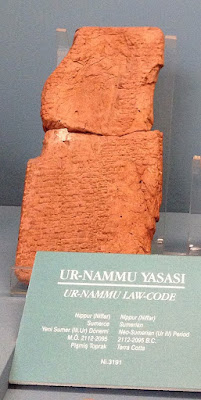By Adrian McGrath
The oldest surviving set of laws that we know of come from the Mesopotamian city-state called Ur, in what is today Iraq. Ur was the home in Sumaria of Abraham, the very same, famous Abraham from the Bible. We are not certain of the exact date the law code was written, but it dates from about 2100 BC. (The Old Testament dates from about 1500 BC probably at its oldest.) This makes the law code of Ur Nammu older than the Bible itself.
We also do not know exactly who wrote the code, but it was probably written by the King of Ur named Ur Nammu or his son. The son was called Shulgi. The code itself was written in a now-extinct language called Sumerian which was the language of the ancient land called Sumer. Sumer existed between the Tigris and Euphrates Rivers in Mesopotamia, which is now central or south Iraq.
It is significant to note that the Code of Ur Nammu is actually older than the Code of Hammurabi, which was probably written about 1780 BC. It is often said that the Hammurabi laws are the oldest known written laws, but actually Ur Nammu's code is older. Hammurabi's Code also came from Mesopotamia. The Ur Nammu Code is about three centuries older than the Hammurabi Code.
It is also significant to note that there may have been older codes or laws than that of Ur Nammu, but this is the oldest to survive to modern times.
The code of Ur Nammu is interesting in that it was not a type of law termed "lex talionis." Lex talionis means a law of retaliation or an "eye for an eye" law where the punishment resembles the crime. Very simplistic. Instead, the Code of Ur Nammu uses what is called "casuistic law."
In casuistic law, precedent is followed based on cases. This creates a situation where If something happens, Then something else is a result. The particular nature of each case is taken into account -- not just a general written rule. Usually, there was a monetary cost to pay for an offense.
There were some capital offenses in the Code of Ur Nammu where a criminal could be executed. Some of these crimes included murder and rape. However, most of the penalties for wrongs done appear to have been monetary -- payment usually in silver to the damaged party.
The code also seemed to mix what is called today criminal law with civil law -- such as a tort (e.g. personal injury) or contract law (e.g. breach of duty) mixed with crimes like murder or adultery (which was a crime in Ur).
The Code of Ur Nammu is considered to be very advanced for its time because it was not a simple "eye for an eye" law code. It is also interesting to note that even in 2100 BC, society felt the need for a legal code to make a nation fully functional.
Sources and further reading:
1. Wikipedia. Code of Ur-Nammu. https://en.wikipedia.org/wiki/Code_of_Ur-Nammu
2. historyofinformation. com. https://www.historyofinformation.com/detail.php?id=1884 The Ur Nammu Law Code, the Oldest Known Legal Code
3. Historic Mysteries. https://www.historicmysteries.com/code-of-ur-nammu/ The Code of Ur-Nammu: the Oldest Law in the World?
4. Note: The photo above of the clay Code of Ur Nammu is from Wikimedia Commons in public domain. Found here https://commons.wikimedia.org/wiki/File:Ur_Nammu_code_Istanbul.jpg



